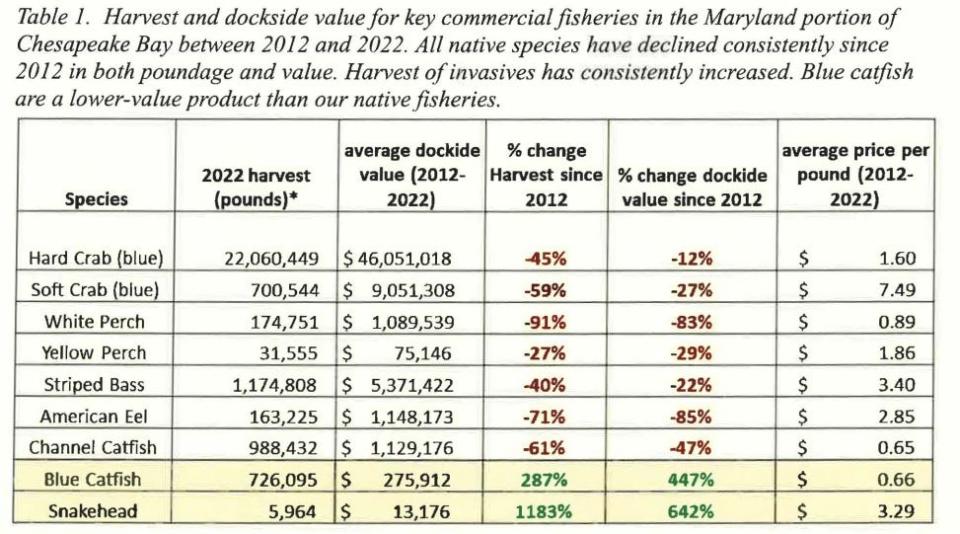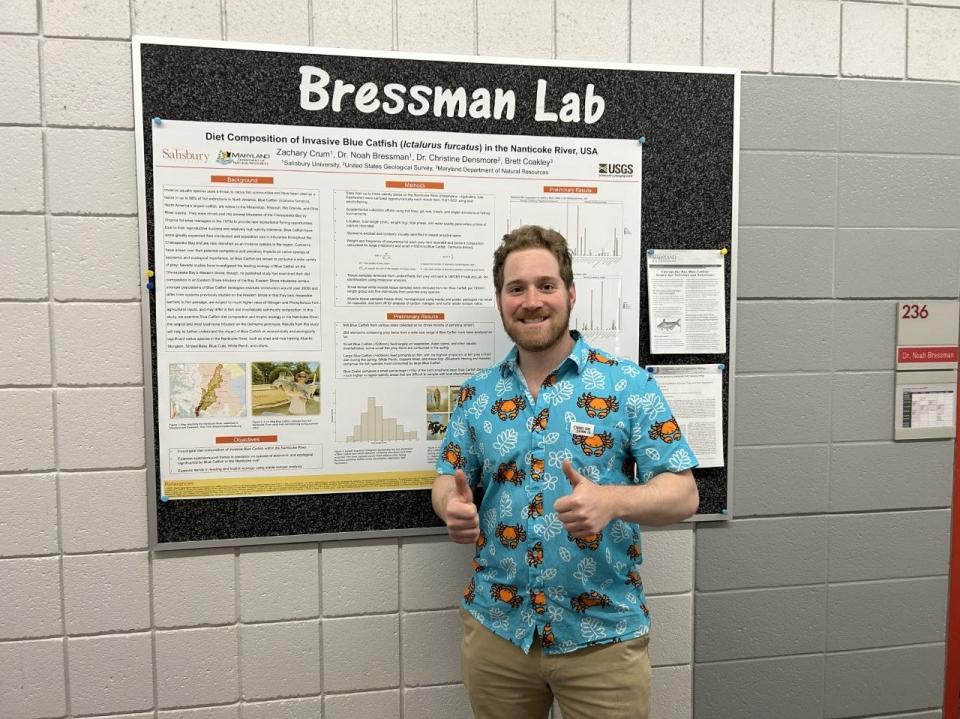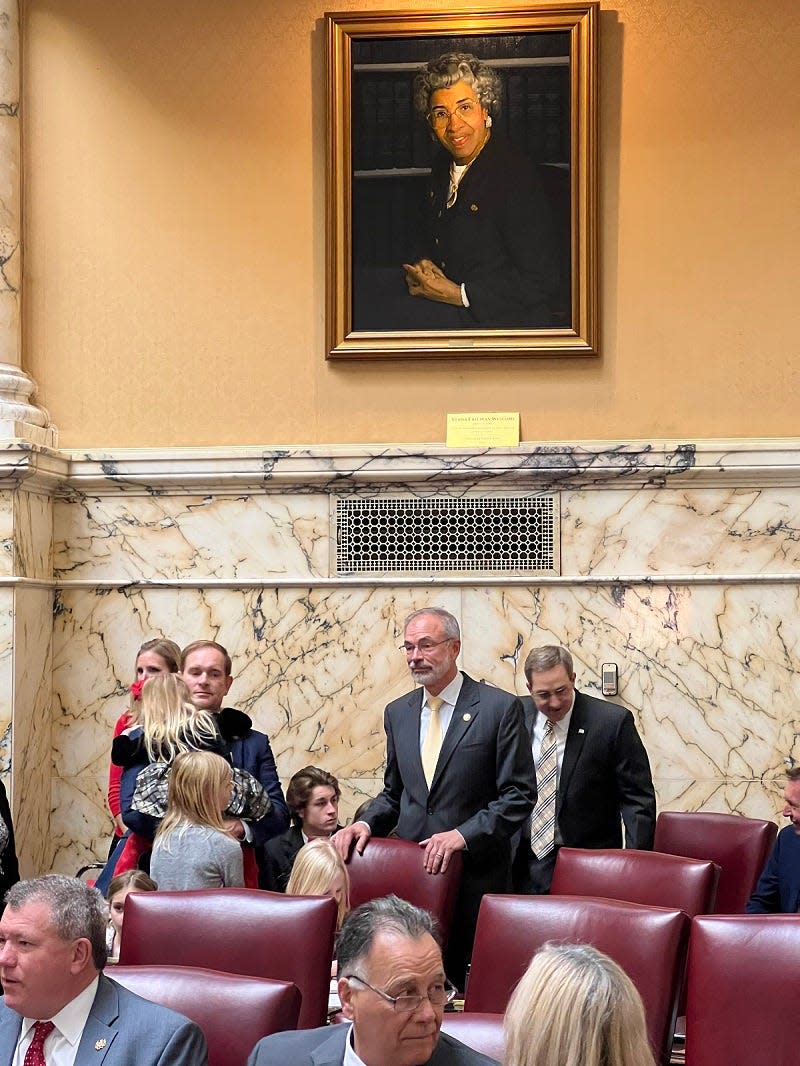Is invasive blue catfish depleting Maryland blue crab? Gov. Moore wants feds to help
- Oops!Something went wrong.Please try again later.
Maryland Gov. Wes Moore asked for federal help on Thursday in an attempt to reel in the invasive blue catfish species for possibly depleting the state’s blue crab population.
Moore wrote United States Department of Commerce Secretary Gina Raimondo requesting an evaluation of what he called “an ongoing commercial fishery disaster in the Maryland waters of the Chesapeake Bay.”
The letter to Raimondo, previously the governor of Rhode Island, calls for federal fishery disaster assistance, and also went to the Maryland congressional delegation.
Moore pointed out the “particular concern” of blue catfish, a species introduced for recreational purposes in Virginia in the 1970s that have spread to dominate the waterways in and around the bay. The whiskered water creature with a recorded world record of 143 pounds accounts for “up to 75 percent of the total fish weight” in tributaries, the letter said.

Blue catfish are the “biggest issue in the Chesapeake Bay right now,” said Delegate Jay Jacobs, an Eastern Shore Republican whose district encompasses Caroline, Cecil, Kent, and Queen Anne’s counties, during a weekly regional delegation virtual meeting on March 17.
The new governor’s letter is clear that “direct links have not been drawn between the presence of invasive species and the observed trends in commercial harvest,” but the missive includes graphs for three species as well as a table showing the change in harvests for nine species from 2012 and 2022. Blue catfish and snakehead, also an invasive species, have increased; the harvests of the other seven on the list have decreased.
As Maryland blue crabs decline, are blue catfish to blame?
Hard blue crabs have declined 45 percent during that period while soft blue crabs declined 59 percent. The state recorded its lowest total of adult male blue crabs last year since a formal process of surveying began in 1990. The blue catfish population has more than doubled over the past decade, up 287 percent from 2012.
While the formal link hasn’t been established, Noah Bressman, an assistant professor in the Biology Department at Salisbury University, cited research from Virginia’s lower James River that showed each blue catfish ate around one to one-and-a-half blue crabs per day on average.
More:Chesapeake Bay adult blue crab numbers hit record low, survey finds
More:Maryland offshore wind push gains momentum with federal help. Here's what lawmakers plan.
Allison Colden, the Chesapeake Bay Foundation’s Maryland senior fisheries scientist, called the governor’s request a “critical first step” in addressing invasive catfish and snakeheads in the bay.
“Federal support would help implement key programs to target harvest of blue catfish and other invasive species to mitigate their ecological damage,” Colden said.
She also pointed to regulatory reforms up for debate in the next farm bill in Congress that could reduce the fish population by removing catfish processing requirements and increasing the harvest.
Dual federal inspection of catfish

“Right now, there’s regulations where catfish is the only fish in the Chesapeake Bay that needs to get both USDA and FDA inspected,” said Salisbury’s Bressman, alluding to the U.S. Department of Agriculture and the Food and Drug Administration who inspect the fish during processing.
He said the dual inspection comes from an era when a lot of catfish prior to their spread came from catfish farms in the Southern states, attributing the stasis in the regulation to “fish farm lobbyists.”
The dual inspection, he said, “makes sense for the farmed fish, but these are wild caught fish.”

U.S. Rep. Andy Harris, whose first district encompasses the Eastern Shore, said a coordinated effort is required to address the invasive species.
“You’re not going to have enough recreational fisherman (to) solve the blue catfish problem,” said Harris, a Republican, during the virtual meeting with the Eastern Shore delegation to the General Assembly.
'Rowing in the right direction'
Last year, he failed in an effort to alter the regulatory regime governing the U.S. Department of Agriculture inspection, which he attributes as a source of the problem.
“Since I chair that (House Appropriations Agriculture Subcommittee),” he told the delegation members, “I’ll be much better positioned this year to do what we attempted to do last year, which is to carve out an exception for invasive species, especially in the Chesapeake Bay.”
More:After 20 years, Maryland is still struggling to get rid of this 'Frankenfish'
Jacobs, the Eastern Shore delegate, said he was glad to see the attention on the issue coming from the governor’s office.

“At least everybody’s sort of in the same boat now,” said Jacobs, a former mayor of the Kent County town of Rock Hall (billed as the “Pearl of the Chesapeake”), “I think we’re rowing in the right direction.”
Dwight A. Weingarten is an investigative reporter, covering the Maryland State House and state issues. He can be reached at dweingarten@gannett.com or on Twitter at @DwightWeingart2.
This article originally appeared on Salisbury Daily Times: Moore calls on feds for help with invasive blue catfish in Maryland

